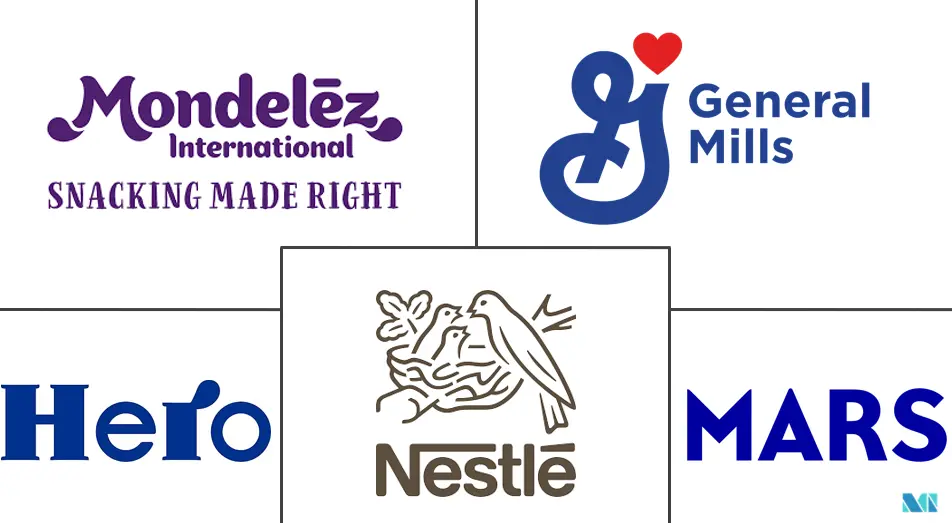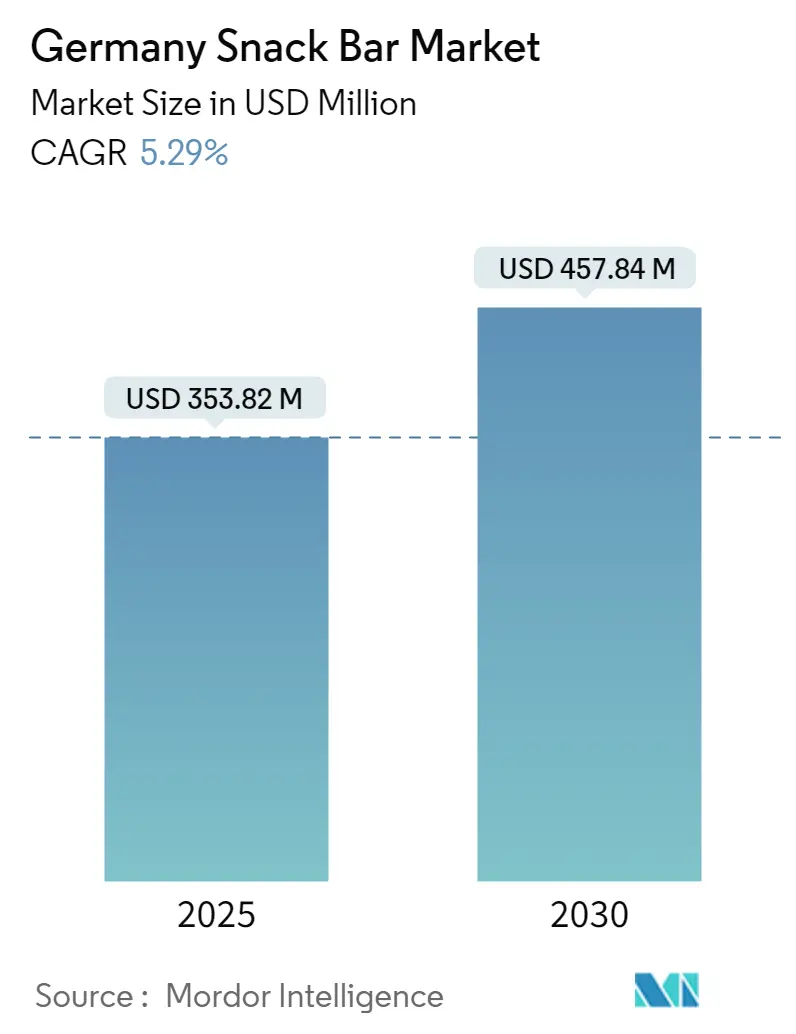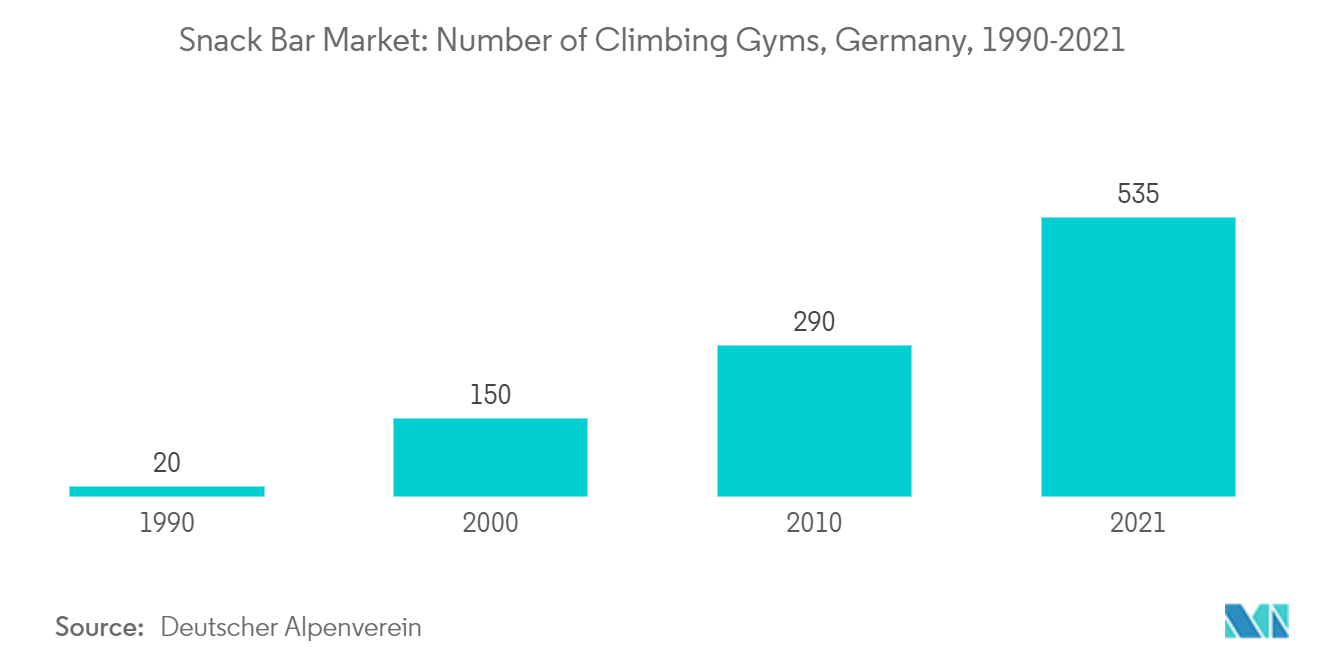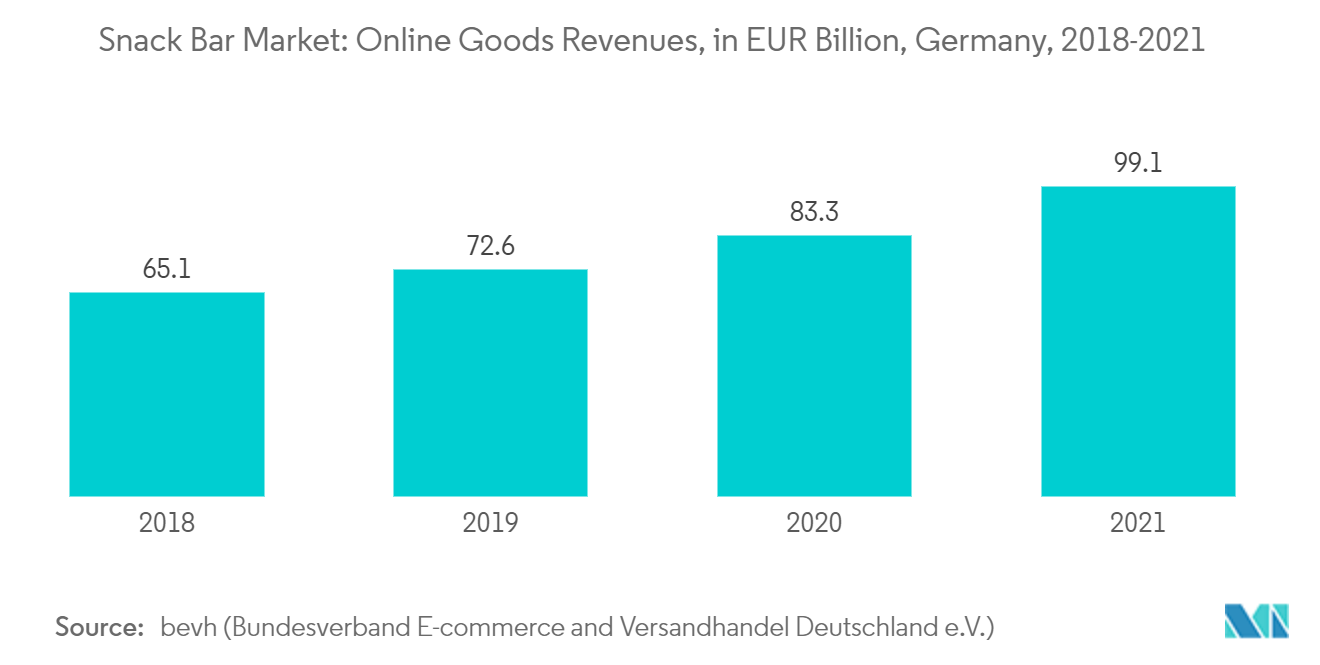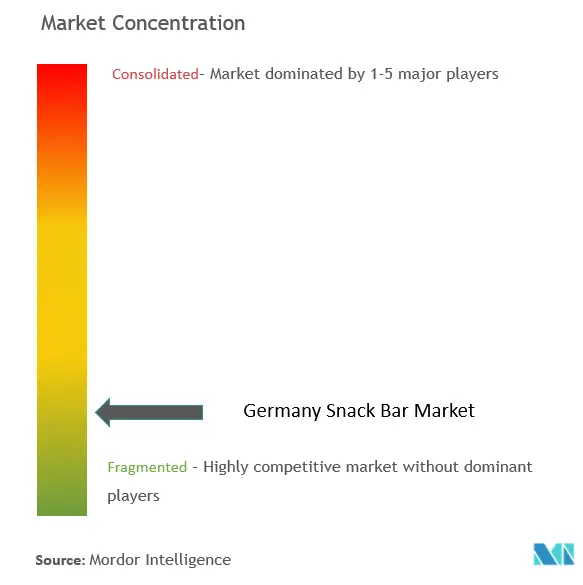Germany Snack Bar Market Analysis
The Germany Snack Bar Market size is estimated at USD 353.82 million in 2025, and is expected to reach USD 457.84 million by 2030, at a CAGR of 5.29% during the forecast period (2025-2030).
The fast-paced German society and the rising number of single households drive the demand for high-convenience food products, including ready-to-eat meals and snack bars. Stores are flooded with various snack bars, like protein-rich, nutritious, and gluten- and dairy-free bars that attract health-conscious consumers. There is a growing demand for cereal bars with superfoods, like chia and quinoa, as they provide nutrition with convenience at the same time. Product innovation has been a key driver that supports visibility and consumer interest and helps attract new clients.
German customers' growing preference for convenient, on-the-go meals and snacks, mostly as a result of their hectic lifestyles, drive the German market. The demand for organic energy bars increased as customers became more aware of the potential negative health impacts of artificial additives such as color, flavor, sweeteners, and preservatives. The evolving retail industry is marked by the emergence of many stores in the hypermarket, supermarket, and convenience stores segments. According to data published by the Bund Ökologische Lebensmittelwirtschaft (BÖLW), which is the main organization for organic food farmers, processors, and merchants across Germany, the sales of organic food increased over the past 10 years, rising from EUR 6.64 billion in 2011 to EUR 15.3 billion in 2022. This trend is expected to last in the long term due to the rising customer interest in the food production process and attention to healthy living. This trend is expected to drive the demand for organic snack bars across the region over the forecast period.
Germany Snack Bar Market Trends
Surge in Demand for Energy Bars
Energy bars have been growing considerably due to their considerable health benefits and convenience of carrying around and consumption. The energy snack bar products are usually marketed as ideal for consumers involved in sports and workouts, owing to their muscle repair properties and low-fat/low-fiber formulation, making them easy to digest, thus, acting as ideal workout snacks. Owing to the increased acceptance of various fitness activities across Germany, ready-to-eat and ready-to-drink products like energy drinks, protein shakes, and energy bars are witnessing a surge in demand. According to Deutscher Alpenverein, in 2021, there were 535 climbing gyms across Germany. In this context, climbing refers to the recreational use of a climbing wall with indoor and outdoor facilities.
Additionally, energy bars claim to have a higher crude protein content when compared to other protein bars, thus encouraging consumers to demand additional protein content in their diet. These bars enhance physical energy, nourish, and give protein and a combination of fats, carbohydrates, minerals, and vitamins.
E-commerce to Witness Robust Growth
With the advancements in the retail sector, the market is experiencing significant sales from online channels. Consumers prefer grocery purchases through online distributors, as a good discount can be redeemed from such purchases. Consumers' increased focus on online shopping has resulted in online sales accounting for a significant share of the market studied. The consumers' acceptance of online products, along with the presence of a diversified product portfolio, is expected to drive the market demand over the forecast period.
The robust growth of the e-commerce landscape has offered unprecedented opportunities for regional snack manufacturers. The portability factor of snacking products has further strengthened the ease of shipping. Thus, the confectionery segment and energy bars are among the largest processed food segments of the e-commerce market. As a result, the sales of snack bars are increasing with the maximum growth rate through e-commerce channels, like Amazon, Flaschenpost, Bofrost, Bringmeister, and other such online retailers across the region.
Germany Snack Bar Industry Overview
Germany's snack bar market is fragmented in nature, with the presence of a large number of domestic and international players in the market. Mondelēz International Inc., Nestlé SA, General Mills Inc., Hero Group, and Mars Incorporated are the major players in the market. New product launches, market expansions, partnerships, and acquisitions are the preferred strategic approaches adopted by companies involved in the German snack bar business. Companies are increasing their investments in R&D and marketing and expanding their distribution channels to maintain their position in the market. They are adopting competitive strategies by investing more to develop unique products with interesting flavors and eco-friendly packaging. The entrance of private labels into this small group is notable and has added a new element of competition, further fragmenting the competition in the market studied.
Germany Snack Bar Market Leaders
-
Mondelēz International, Inc.
-
Nestlé S.A.
-
General Mills, Inc.
-
Mars Incorporated
-
Hero Group
- *Disclaimer: Major Players sorted in no particular order
Germany Snack Bar Market News
- March 2023: Nestlé SA invested in a Munich-based German meal replacement company YFood. YFood is a start-up that offers a range of meal replacement products, including snack bars, complete nutrition drinks, and drink powders.
- August 2022: Mondelēz International Inc. announced the completion of the acquisition of the snack bar firm Clif Bar & Company, which also offers snack bars in Germany.
- October 2021: Mondelez International tested future-focused snacking options created by its SnackFutures Innovation Hub at German supermarkets. The new products were claimed to contain snack balls manufactured from organically grown raw materials and vegan snack bars.
Germany Snack Bar Industry Segmentation
Snack bars are versatile product options that can contain cereals, fruits, and nuts to provide consumers with healthy nutrients, bioactive compounds, and dietary fiber.
The German snack bar market is segmented by product type and distribution channel. Based on product type, the market is segmented into cereal bars, energy bars, and other snack bars. The cereal bars are segmented into granola/muesli bars and other cereal bars. The market is also segmented by distribution channels, including hypermarkets/supermarkets, convenience stores, online retail stores, specialty stores, and other distribution channels. For each segment, the market sizing and forecasts have been done on the basis of value (in USD million).
| Product Type | Cereal Bars | Granola/Muesli Bars |
| Other Cereal Bars | ||
| Energy Bars | ||
| Other Snack Bars | ||
| Distribution Channel | Hypermarkets/Supermarkets | |
| Convenience Stores | ||
| Online Retail Stores | ||
| Speciality Stores | ||
| Other Distribution Channels |
Germany Snack Bar Market Research FAQs
How big is the Germany Snack Bar Market?
The Germany Snack Bar Market size is expected to reach USD 353.82 million in 2025 and grow at a CAGR of 5.29% to reach USD 457.84 million by 2030.
What is the current Germany Snack Bar Market size?
In 2025, the Germany Snack Bar Market size is expected to reach USD 353.82 million.
Who are the key players in Germany Snack Bar Market?
Mondelēz International, Inc., Nestlé S.A., General Mills, Inc., Mars Incorporated and Hero Group are the major companies operating in the Germany Snack Bar Market.
What years does this Germany Snack Bar Market cover, and what was the market size in 2024?
In 2024, the Germany Snack Bar Market size was estimated at USD 335.10 million. The report covers the Germany Snack Bar Market historical market size for years: 2019, 2020, 2021, 2022, 2023 and 2024. The report also forecasts the Germany Snack Bar Market size for years: 2025, 2026, 2027, 2028, 2029 and 2030.
Our Best Selling Reports
Germany Snack Bar Industry Report
Statistics for the 2025 Germany Snack Bar market share, size and revenue growth rate, created by Mordor Intelligence™ Industry Reports. Germany Snack Bar analysis includes a market forecast outlook for 2025 to 2030 and historical overview. Get a sample of this industry analysis as a free report PDF download.

